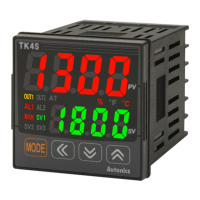6 Parameter Settings and Functions
62 © Copyright Reserved Autonics Co., Ltd.
6.3.2.1 Hysteresis Settings
An ON/OFF control feature is used to define the control output ON/OFF points.
ON_Hysteresis sets the output on point and OFF_Offset sets the off point.
Setting hysteresis too low can result in hunting induced by disturbance (noise,
chattering, etc.). To minimize hunting, set ON_Hysteresis and OFF_Offset values
according to the heater or cooler's capacity and thermal characteristics, control
subject and sensor response characteristics, installation conditions, and other
defining factors.
Group
Preceding
Condition
Parameter Range
Factory
Default
Control
Operation
Group
Heating
and
Cooling
Heating
Heating_ON Hysteresis 1~100 2
Heating_OFF Offset 0~100 0
Cooling
Cooling_ON Hysteresis 1~100 2
Cooling_OFF Offset 0~100 0
6.3.3 PID Control
PID control is a combination of proportional (P), integral (I), and derivative (D)
controls and offers superb control over control subjects, even with a delay time.
Proportional control (P) implements smooth, hunting-free control; integral control (I)
automatically corrects offsets; and derivative control (D) speeds up the response to
disturbance. Through these actions, PID control realizes ideal temperature control.
How to apply PID control
Proportional (P) control: Set both integral and derivative times to
0 after PID control is selected.
Proportional-Integral (PI) control: Set the derivative time to 0
after PID control is selected.
Proportional-Derivative (PD) control: Set the integral time to 0
after PID control is selected.
When using the multi-SV function, the same PID time constant
will be applied to SV0 to SV3.
